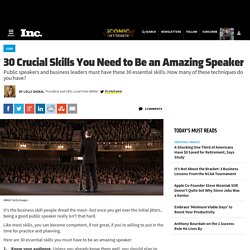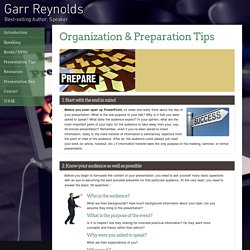

Presentation skills resources - Biz-E-training. How to sound smart in your TEDx Talk. How to Handle Audience Skepticism. By nature, human beings are risk averse.

People will go to great lengths to avoid potential negative outcomes — much greater lengths than they will go to attain potential positive ones. This orientation toward the status quo often compels us to be suspicious of new things. Anyone in the business of presenting novel ideas, from entrepreneurs to product marketers, must be prepared for these objections and questions. Often, how we respond to these doubts dictates how our ideas will be received.
So how do you prepare? Framing Is the Key We’ve all heard the trite phrase, “Challenges are opportunities in disguise.” For example, to short-circuit an audience’s suspicion of new ideas, whenever possible use language that highlights the positive aspects of your subject, such as the potential benefits and successes. Framing Types and Techniques Objections of the Heart You can recognize emotional objections by their inherent lack of data or their focus on what might happen at some point in the future. TED TALKS: “ONE SIZE FITS ALL” You are a good teacher.

You work tirelessly to inspire creativity and motivation in your students. The list of bookmarked TED-videos in your computer is longer than the Great Wall of China. But you won’t have the time to design lesson plans with worksheets and handouts around these videos. If it is so, this post will come in handy. Here is a worksheet with a set of activities for taking any TED talk (or any similar video) and using it in class with the least amount of preparation time on your part. A TED talk’s title is usually snappy and sums up the idea of the talk. Write the title of the talk on the board (e.g. the recent talk I showed to my class – What Makes a Good Life. Designing conference posters - Colin Purrington. A large-format poster is a big piece of paper or wall-mounted monitor featuring a short title, an introduction to your burning question, an overview of your novel experimental approach, your amazing results in graphical form, some insightful discussion of aforementioned results, a listing of previously published articles that are important to your research, and some brief acknowledgement of the tremendous assistance and financial support conned from others — if all text is kept to a minimum (less than a 1000 words), a person could fully read your poster in 5-10 minutes.

Section content • DOs and DON’Ts • Adding pieces of flair • Presenting • Motivational advice • Software • Templates • Printing • Useful literature • Organizing a poster session What to put in each section Below, I’ve provided rough tips on how many words each of these sections might have, but those guesses are assuming you have a horizontal poster that is approximately 3×4′. Adjust accordingly. DOs and DON’Ts 1. 2. 3. 30 Crucial Skills You Need to Be an Amazing Speaker. It's the business skill people dread the most--but once you get over the initial jitters, being a good public speaker really isn't that hard.

Like most skills, you can become competent, if not great, if you're willing to put in the time for practice and planning. Presentation Bad/Good Examples. Do Your Slides Pass the Glance Test? - Nancy Duarte. By Nancy Duarte | 11:00 AM October 22, 2012 An audience can’t listen to your presentation and read detailed, text-heavy slides at the same time (not without missing key parts of your message, anyway).

So make sure your slides pass what I call the glance test: People should be able to comprehend each one in about three seconds. Think of your slides as billboards. When people drive, they only briefly take their eyes off their main focus — the road — to process billboard information. Similarly, your audience should focus intently on what you’re saying, looking only briefly at your slides when you display them. Keep It Simple Research shows that people learn more effectively from multimedia messages when they’re stripped of extraneous words, graphics, animation, and sounds. Nancy Duarte: The secret structure of great talks.
Organization & Preparation Tips. Before you even open up PowerPoint, sit down and really think about the day of your presentation.

Garr Reynolds Official Site. Structure Your Presentation Like a Story - Nancy Duarte. By Nancy Duarte | 8:00 AM October 31, 2012 After studying hundreds of speeches, I’ve found that the most effective presenters use the same techniques as great storytellers: By reminding people of the status quo and then revealing the path to a better way, they set up a conflict that needs to be resolved.

That tension helps them persuade the audience to adopt a new mindset or behave differently — to move from what is to what could be. And by following Aristotle’s three-part story structure (beginning, middle, end), they create a message that’s easy to digest, remember, and retell. Here’s how it looks when you chart it out: And here’s how to do it in your own presentations.
Craft the Beginning Start by describing life as the audience knows it. Nancy Duarte: The secret structure of great talks.